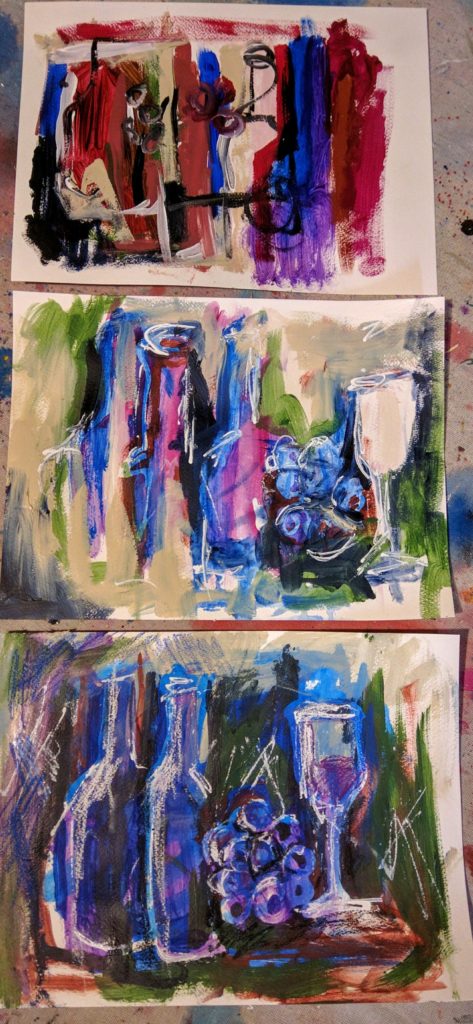Oh My! I have friends in Oregon with a wonderful custom built home up on a hill overlooking the Columbia River. The house is amazing, very modern and well built; and they have been saving a wall in the dining room for a perfect piece of art . . . by me. I’m thrilled. It’s a great room, a great house and wonderful people.
The theme of the dining room is wine. Everything in the room, from colors to centerpiece to visible nick-nacks reflects the cork, bottle and stemmed glass culture of wine enjoyment. There are big windows all along the back of the house, including this room, but the color scheme throughout is subdued: colors in the mid to dark range in browns, reds and greys. As I looked at the wall I realized that a piece with lots of white or light would overwhelm everything. I needed to stick to darker, more winey tones: purples, reds, rusts, with a touch of green.
I started noodling with color yesterday, doing some tests and studies to see what would work. I did three quick trials – and was pretty pleased with myself!  I liked what I was seeing! So I sent a photo of the three studies off to Mike for an opinion. When he got home, he told me that, of the three, he liked the first one best – the one with no attempt to insinuate wine bottles or grapes. I was taken aback. That was supposed to just be a color sample. The other two pieces were more what I was thinking for the actual painting.
I liked what I was seeing! So I sent a photo of the three studies off to Mike for an opinion. When he got home, he told me that, of the three, he liked the first one best – the one with no attempt to insinuate wine bottles or grapes. I was taken aback. That was supposed to just be a color sample. The other two pieces were more what I was thinking for the actual painting.
When pressed, he said, ‘That’s not you. It doesn’t look like your work. It looks like you’re trying to make something someone else may like. Don’t draw in bottles and grapes and glasses. That’s not what you do. It’s not true.’
My gut twisted because I knew he was right. I could also remember what I wrote in this blog not too long ago:
. . . if this work is trying to resolve as a landscape, maybe something with the suggestion of mountains and a lake, the worst thing to do would be to draw in those things, to add them to the piece. If it is trying to be a portrait, for God’s sake, don’t draw in the eyes or nose, or lips! Have the discipline and confidence to let the suggestion be enough. Instead, look for what interferes with that suggestion, look for what you might remove or paint over.
And here I was, going 180 degrees away from what I advocated!
The problem was the commission, the agreement to make a piece specifically for a person and a place. It is very different than selling a piece that already exists, that someone finds, loves and buys. I can become overwhelmed with the pressure to produce something that the patron will adore; and since my work is utterly abstract, with little in the real world to hang on to, my assumption is that people would be more comfortable with pictures of THINGS over their dining table!
I talked with my mentor, Theresa, about this once. She told me she no longer takes a commission to do a particular THING or a painting LIKE something else she’s done. She agrees to the size and shape of the piece and a basic palette. Then she goes to work, forgetting about the commission as much as possible, simply doing her process. If the patron likes the finished piece, they buy it. If it doesn’t hit the mark – no failure, no foul, and no purchase. She doesn’t take deposits or anything like that.
I think that’s a pretty good way to go about it. These people like my work. They like how they experience it. The worst thing I could do would be to go into my head and start creating something I think they might like better.
The thought of which takes me to a completely different place.
One of the hardest things to do in life – and it is symptomatic of a successful life – is to be genuine, to be who you are without reservation at all times. When your thoughts, your words and your actions all align, it is nearly magical. Life flows easily with few doubts, distractions and detours.
Most of us never really get there. We have a persona we present to the world, another we present to the digital world and then a secret self we keep deep inside. With empathy, even sympathy, I say that’s completely understandable . . . but it is still dishonest.
My painting works when it is honest: when the pigment flows directly from my thoughtless head, through time onto the canvas. It becomes false when I attempt to control that process, when my verbal brain takes over and I try to make things happen.
Funny; that’s true of my life, as well.

James Dingman
27 Dec 2016I still like #2 . . . in a Holiday Inn kinda way!